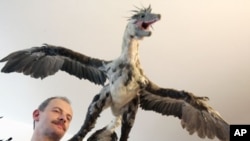Paleontologists say winged dinosaurs with glossy feathers likely used their flashy plumage to attract a mate in the same way as their modern descendants - birds.
Researchers from the U.S. National Science Foundation teamed up with experts from China's Beijing Museum of Natural History to study a newly-discovered dinosaur fossil they say is the earliest known record of iridescent color in feathers.
The fossil is that of a four-winged, pigeon-sized dinosaur called a Microraptor that lived about 120 million years ago during the height of the dinosaur age - the Cretaceous period. The bird-like dinosaur’s long, narrow tail was adorned with a pair of so-called streamer feathers.
After comparing the detailed pattern and color of dinosaur feathers to those of modern birds, the scientists believe the Microraptor's plumage was an iridescent black, with the same glossy sheen as the feathers of a modern crow.
Many bird species have lustrous feathers that seem to be designed for mate-attracting displays. The paleontologists say evidence that Microraptor plumage was largely iridescent suggests that feathers, in general, were important for display even at a relatively early point in their evolution, some 120-million years ago.
The new study is published in the journal Science.
News
Earliest Fossil of Iridescent Dinosaur Feathers Reveals New Behavior Clues









